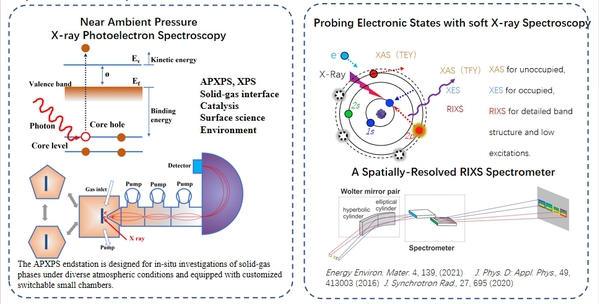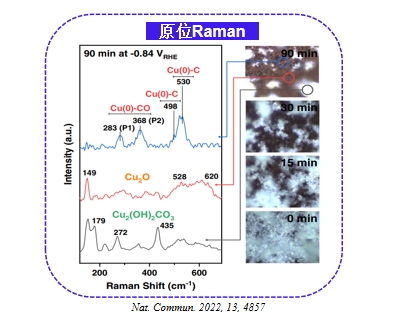- Mass Spectrometry for Energy Transformation and Astrochemistry
- Extreme Ultraviolet Electronic Structure Characterization and Lithography
- Electronic Structure Characterization for Operando Micro/Nano Devices
- High-sensitive, Space-Resolved and Time-Resolved Electron Spin Dynamics
- In-situ/Operando Soft X-ray Spectroscopy and Scattering
- Soft X-ray Ptychographic Nanoscopy
- Resonant Coherent Scattering
- High Throughput In-situ/Operando Tender X-ray Spectroscopy
- Tender X-ray Spectromicroscopy and Ptychography
- Test Beamline
Experimental Technique

Beamline optics

Overview
This beamline, powered by the Linear Polarizing Undulator (LPU), supports in-situ soft X-ray spectroscopy and scattering experiments across 180-2500 eV with a resolution of 15000@244.4 eV and optimized photon flux. It features an SX700 monochromator with 400/800/1200 l/mm dual gratings and precision M1-M6 mirrors for beam splitting and focusing. The main line focuses at 63.5 m for the Near Ambient Pressure X-ray Photoelectron Spectroscopy (NAPA) endstation, while the branch line focuses at 69.0 m for the in-situ photon-in photon-out spectroscopy (MARS) endstation, both utilizing a 1° grazing incidence design. Enhanced by water cooling and radiation protection, the system ensures high resolution, high flux, and reliable performance for both stations.
Key Performance

Experimental Endstation
A-Branch: NAPA

Key Performance

Overview
Branch A (NAPA) is a Near Ambient Pressure X-ray Photoelectron Spectroscopy (APXPS) endstation optimized for in-situ investigations of solid-gas phases under diverse atmospheric and reaction conditions. Equipped with a custom-designed four-stage differential pumping system featuring a Si3N4 window (available), it enables vacumm transition between the KB chamber and the analysis chamber. This endstation aims to expand the application range of APXPS through the design of rapidly switchable small chambers, and covers a broad X-ray energy range from 180 eV to 2500 eV—facilitating comprehensive surface characterization.
I. Preparation chamber
-6 samples can be loaded (flag-type sample plate)
-sample can be treated between 150 K to 1300 K;
-Argon sputtering;
-evaporator positions and ports for user equipment available;
II. Switchable chamber
-small volume and rapidly switchable, customized according to users
-Integrated laser heating and resistance heating sample holder, with a temperature range of 300 K to 1300 K
- 6 gas lines equipped with individual mass flow controllers (MFCs)
III. UHV chamber
Traditional surface science analysis in high vacuum under 150~1300 K.
B-Branch: MARS

Key Performance

Overview
Branch B is an in-situ photon-in photon-out spectroscopy endstation (MARS), designed to collect X-ray absorption spectroscopy (XAS), X-ray emission spectroscopy (XES), and resonant inelastic X-ray scattering (RIXS) pectroscopy . This suite of techniques probes both unoccupied and occupied electronic structures, as well as elementary excitations—including crystal field splitting, charge transfer, and excitations related to spin, charge, orbital, and lattice degrees of freedom. The endstation operates over a broad X-ray beam energy range from 180 eV to 1800 eV and is equipped with in-situ capabilities, enabling detailed investigation of electronic structure and dynamics in complex materials.
I. Loadlock
Up to 20 samples can be loaded (flag-type sample plate);
II. Prepare chamber
sample can be heated up to 1200 K;
4 evaporator positions available once requested;
III. Main chamber
In-situ atmosphere up to 1 bar maximum;
IV. Spectrometer
30 meV energy resolution and 3 um spatial resolution。
Science

Scientific Scope 1: Utilizing Resonant Inelastic X-ray Scattering (RIXS) for in-situ/operando investigations of alkali-ion battery systems enables comprehensive probing of electronic structure evolution during charge-discharge processes. This capability is crucial for tracking dynamic changes in redox-active transition metal centers and oxygen states, providing insights into charge compensation mechanisms and structural stability. Furthermore, it allows for the identification of intermediate phases and the quantification of electronic structure modifications at different states of charge, offering a deeper understanding of degradation pathways. Finally, RIXS is indispensable for resolving the interplay between electronic and structural dynamics in working battery materials, bridging the gap between theoretical predictions and experimental observations of energy storage mechanisms.

Scientific Scope 2: Near-Ambient Pressure X-ray Photoelectron Spectroscopy (NAP-XPS) enables in-situ investigation of reaction gas adsorption mechanisms on model catalyst surfaces under varying pressure conditions. This technique provides atomic-level insights into the dynamic interplay between surface adsorbates and catalytic active sites, revealing pressure-dependent adsorption configurations and reaction intermediates. By monitoring changes in chemical states and binding energies of surface species, NAP-XPS elucidates the influence of pressure on adsorption kinetics and surface coverage. Furthermore, it allows for the identification of critical pressure thresholds that govern catalytic activity and selectivity, offering a comprehensive understanding of the structure-activity relationship in reaction gas adsorption process under realistic operating conditions.

Scientific Scope 3: NAP-XPS employs tunable energies and micro-beams to study material composition and electronic structure across regions and depths, enabling spatial resolution and subsurface insights under near-ambient conditions.

Scientific Scope 4: In-situ RIXS probes photoelectrocatalytic reactions, revealing dynamic electronic changes, reaction intermediates, and charge-lattice interactions, while identifying efficiency and stability factors.
People

Useful Link
Related beamlines:
RIXS beamlines:
http://e-ssrf.sari.ac.cn/beamlines_2024/sr_72267/beamline_maps/bl09u/xzjs/
https://www.diamond.ac.uk/Instruments/Techniques/Scattering/RIXS.html
https://www.maxiv.lu.se/beamlines-accelerators/beamlines/veritas/
NAP-XPS beamlines:
https://www.maxiv.lu.se/beamlines-accelerators/beamlines/hippie/
https://www.helmholtz-berlin.de/pubbin/igama_output?modus=einzel&gid=1671&sprache=en
https://www.specs-group.com/specs/products/detail/nap-xps-system-with-spm-and-irras/
https://www.cells.es/en/instruments/beamlines/bl15-3sbar

